Evony Layering Guide: Building Troop Layers For Attack And Defense
In-depth guide on how troop layers work, why they are needed, and best defensive and offensive layer builds in Evony
Last Updated: 3 years ago
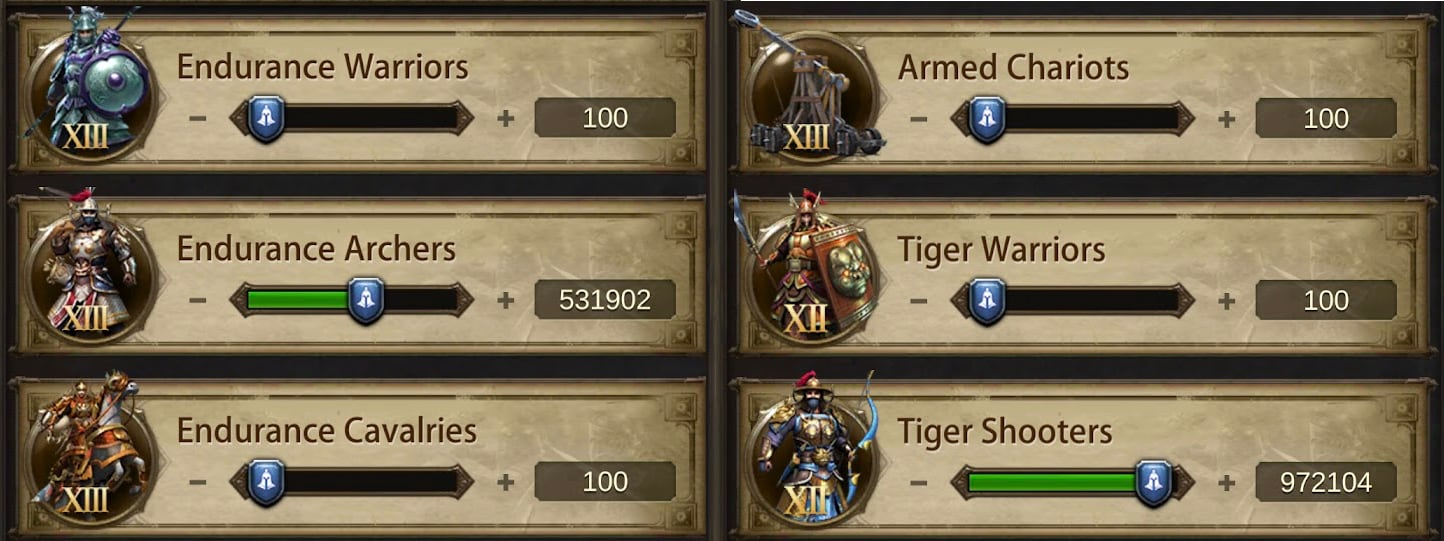
Layering Troops for Attack and Defense in Evony
An important part of PvP combat in Evony The King's Return is to create both offensive layers and defensive layers of troops for the best army composition. This technique is so common, that most players just refer to troop tier layering as "layers".
There are two types of layers, thick defensive layers of troops to protect your city, and thinner offensive layers for your attack marches.
This guide will go in-depth on how layers work, why they are needed, and how building layers can be sometimes more of an art than a science.
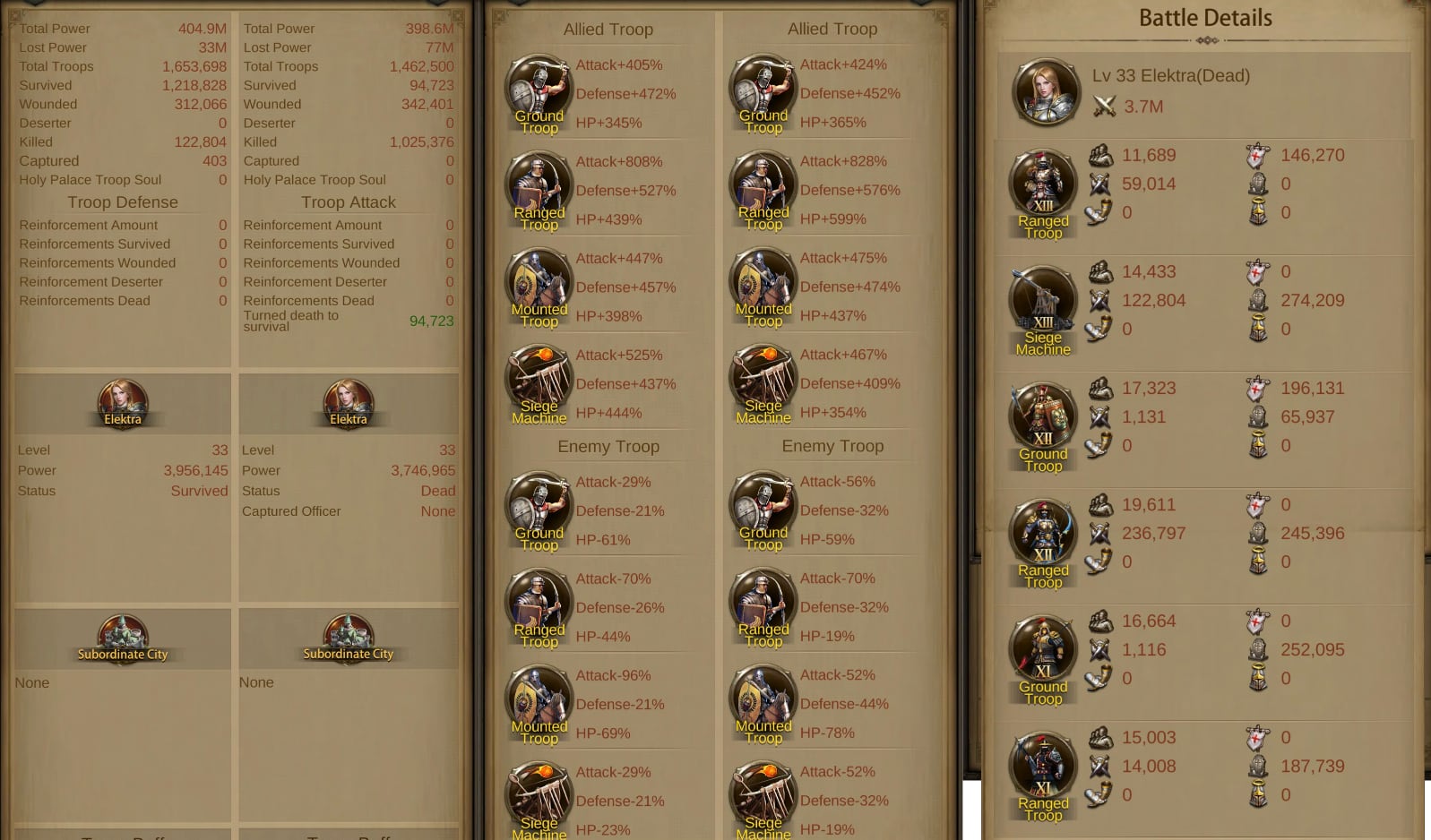 Evony Guide to Layers - Example of similar ranged marches, similar buffs, the march with better layers win big time
Evony Guide to Layers - Example of similar ranged marches, similar buffs, the march with better layers win big time
The Underlying Mechanics of Why Layers Work in Evony
Disclaimer: Battle mechanics in Evony are not public information, so much of the information below are battle tested theories. However, there will be proof of these theories below.
Two important mechanics that shape how and why layers work are:
- Pvp battles occur with multiple "hidden" rounds
- Each troop type at each tier targets one enemy type and tier per round
Hidden Rounds of Each Battle in Evony
Although you get instant battle reports, PvP combat in Evony actually occurs in stages or rounds behind the scenes.
This is backed by the fact that each troop type of each tier has five battle-relevant attributes:
- Attack
- Defense
- HP
- Speed
- Range
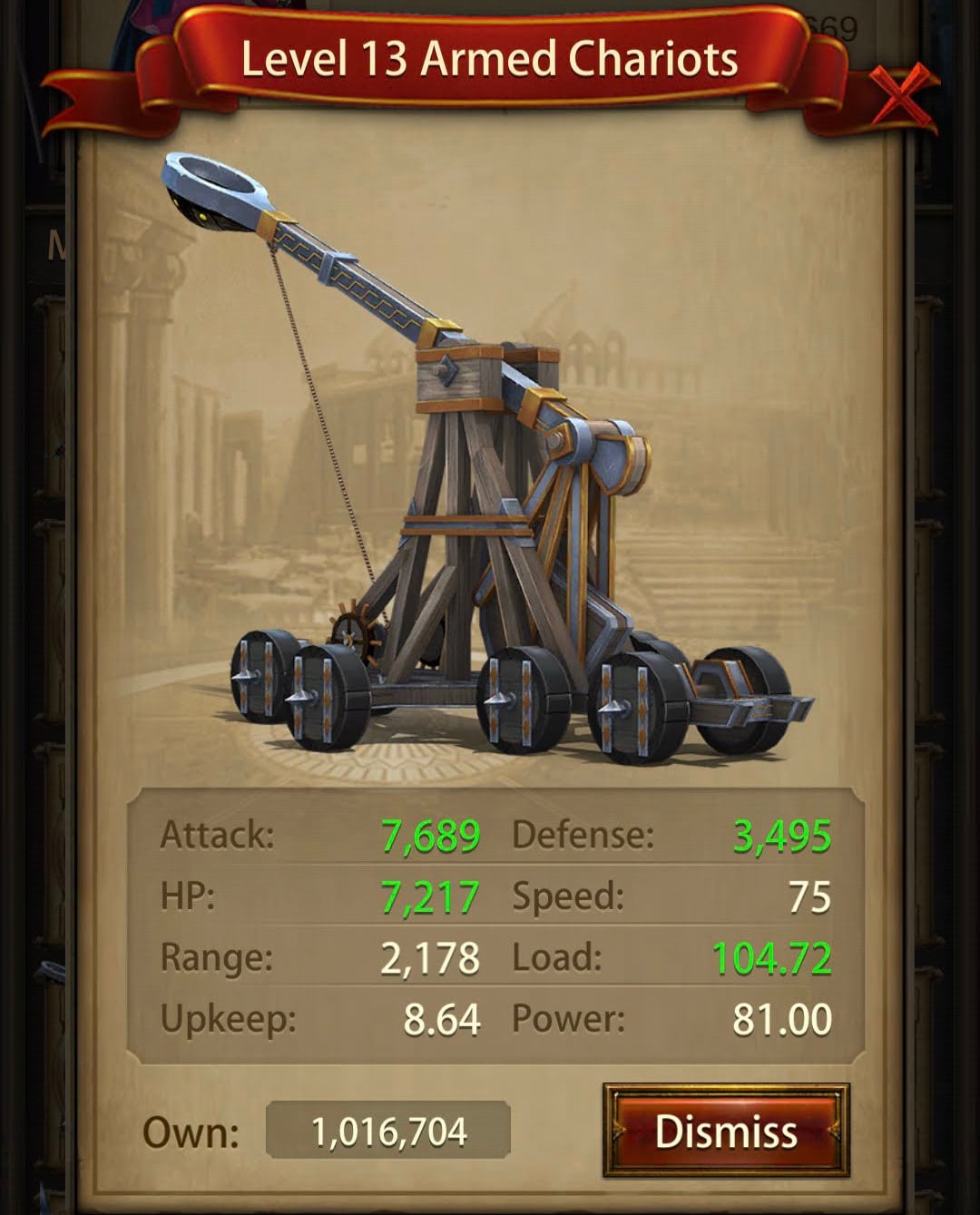 Evony Guide to Layers - Seige machine attributes
Evony Guide to Layers - Seige machine attributes
While attack, defense and health points can exist without rounds or turns, the speed and range cannot exist without rounds.
Both ranged and seige have much longer range than cavalries or ground. This means they can start shooting at enemies from further away. On the other hand, cavalry and ground has a higher speed, so they close the gap between them and their enemies per round.
This mechanic, in combination with the different distributions of attack, defense and hp points, also supports the natural counters for each type. Range outpower horses, horses outpower ground, and ground counters archers.
Troop Types Target one Enemy Type per Round
At each turn, each troop type at each tier has their own location and attributes, and choose one target group of enemies. While over the course of an entire battle, that troop type/tier can kill multiple types or tiers of enemies, at each turn, they target only a single one.
If this was not true, the developers would have to implement some kind of logic to split troops to target different enemies, which would result in an inconsistent outcome per battle. In addition, if troops can target multiple types of enemies per round, layers would not work in Evony - but they do.
How Battle Mechanics Influence Layered Builds
Given the two battle mechanics above, we can begin to understand why someone with lots of layers has a large advantage over someone without.
Let's assume we have two players A and B, both similar size, power and buffs. Player A sends a march full of T13 archers. Player B sends a march the same size, but with 90% T13 archers and the rest layers of all other 51 troop tiers (T1-T13 times 4 - 1).
Player A's T13 archers has to waste 51 rounds targeting each of those other troop tiers. On the other hand, player B's T13 archers have a 51 round advantage, hitting only the T13 archers available.
The end result is always a massive win for player B, with layers.
Evony TKR - Defensive Troop Layers
Defensive troop layers in Evony are less up for debate, everyone usually has them and they are not too different. In general, the bigger each defensive layer is, the better it is for you because your keep is not limited by march size.
The one thing to consider is keeping the overall number of troops you have manageable, and still being able to ghost if you are not fully able to defend against large keeps.
A general guide for the amount of troop layers per keep level:
- Keep 25 or Lower - 5k to 10k of each troop tier of each type
- Keep 26-30 - 20k to 50k of each troop tier of each type
- Keep 30-33 - 50k to 100k of each troop tier of each type
- Keep 33-35 - 200k+ of each troop tier of each type - you likely won't be able to ghost, so get those layers as large as possible
At higher level keeps, level 30 or above, you will also want to work on your T12, T13 and maybe even T14s for PvP attack marches.
A good general goal is try to even out each of the three types (mounted, archers, ground) and eventually have at least 1 million of each troop type above T12.
Seige is a fantastic defense for your city, and often will clear out many enemies before they have a chance to reach your city. Do not neglect your seige as part of your defense layers, as the T13 and T14 seige has the longest range of any unit in the game.
Evony TKR - Attack Troop Layers
You will eventually have at least three main attack marches, one for archer, one for cavalry and one for ground. Other late game marches include seige rally march (seige bomb), and a hybrid archer/seige march.
We will focus on the three main "pure" marches here.
Evony TKR - The Best Ranged Layered March
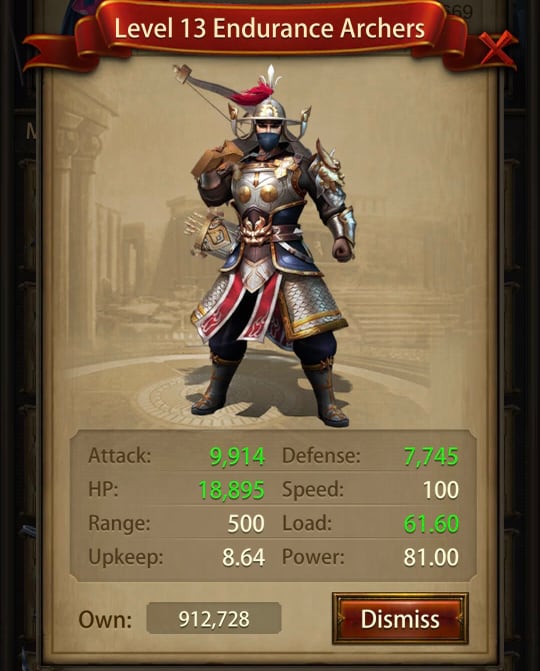 Evony Guide to Layers - Archer or ranged attributes
Evony Guide to Layers - Archer or ranged attributes
The basic formula for building your ranged layered march is:
- 25-40% of your top tier ranged
- 25-40% of your second tier ranged
- 10-40% of your third tier ranged
- 0.25-2% of all other ranged tiers
- 1-10000 of all other troops
Yes, these are very wide ranges for each troop type, so your ranged march shouldn't be very different from the formula above.
The reason the ranges are wide is that the specific percentage or number for you depends on your specific circumstance.
If you have unlocked T14s, your best march can look like 500k of each T14, T13, T12 archers, 20k of each of the other archers and all other troops at 1000. However, if you want to send out a cheaper march, you can also do 250K T14, 350K T13 and 900K T12, 20k of other archers and all other troops at 1000.
If you are a smaller player, having layers at 1000 is too much for your march size, so maybe your ideal march is 300k T12, 100K T11, 50K T10s and only 100 for all other troops.
The size of the layer for all other troops (many people use 1000, I use 10-2000) is more of an art than science. Layers of 2000 will beat layers of 1000 all other things equal, for a larger player.
However, larger layers also means less room for your most powerful ranged troops and not focusing on the type your general is optimized for.
Scout your enemy and update your layers accordingly. Layering means tricking the enemy troops into under-utilizing their power. With a good idea of what your enemy's layers look like (or whether they have layers at all), you should be able craft the optimal layered march to counter.
Evony TKR - The Best Ground Layered March
 Evony Guide to Layers - Ground attributes
Evony Guide to Layers - Ground attributes
The formula for building your ground layered march is:
- 35-60% of your top tier ground
- 15-30% of your second tier ground
- 5-20% of your third tier ground
- 0.25-2% of all other ground tiers
- 1-10000 of all other troops
The formula for ground layers is a little different from ranged troop layers. Ground is mainly used to counter range, and their heavy HP and defense is a natural advantage.
Ground's speed stays the same for each tier, but their attack, defense and health increases for each tier. So every tier of ground moves in battle at the same speed per round, but higher tier ground troops are much less vulnerable.
This is why ground marches tend to be more top heavy than ranged marches. You will still want ground layers, and all other troop layers to counter enemy layers.
If you unlocked T14's, an example march can be 800k T14, 500k T13, 200k T12, 20k all other ground and 1000 other troops.
Evony TKR - The Best Mounted Layered March
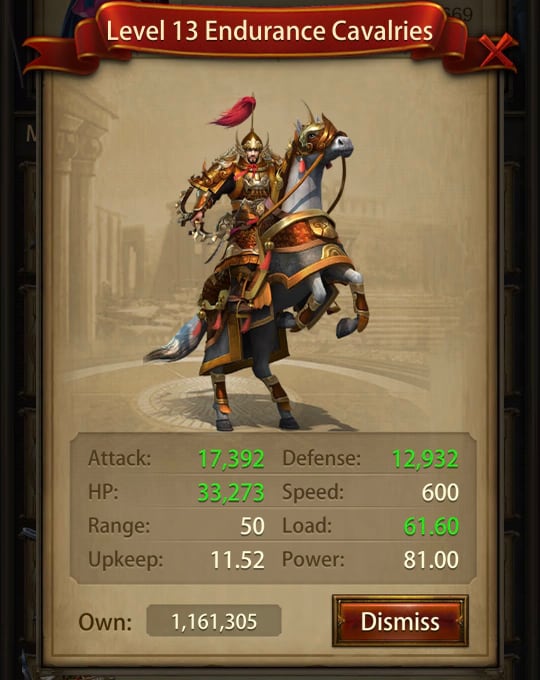 Evony Guide to Layers - Mounted or cavalry attributes
Evony Guide to Layers - Mounted or cavalry attributes
The formula for building your mounted layered march is:
- 35-60% of your top tier cavalry
- 15-30% of your second tier cavalry
- 5-20% of your third tier cavalry
- 0.25-2% of all other cavalry tiers
- 1-10000 of all other troops
Similar to ground, cavalry has increased attack, health and defense for each higher tier. They are mainly used as a ground counter and their high speed and attack gives them an advantage.
To maximize mounted effectiveness, you want to increase attack and HP. This is one reason why mounted attack marches also tend to be more top heavy than ranged PvP marches.
If you unlocked T14's, an example march can be 700k T14, 500k T13, 200k T12, 30k all other mounted and 1000 other troops.
Layering Troops in Evony Summary
All experienced players layer their troops, both defensively and offensively. Layers create a huge PvP advantage over someone that does not, and can often determine how effective someone is holding a building in Battlefield or temple in Server War.
Ultimately, the exact numbers for the best layers for you depends on a variety of factors - your level, your available troops, and your enemy keep/march.
However, the tried and true formulas for successful pure attack marches are very similar, your march should have 70-90% of your top three levels of that type, and layers all the way through.